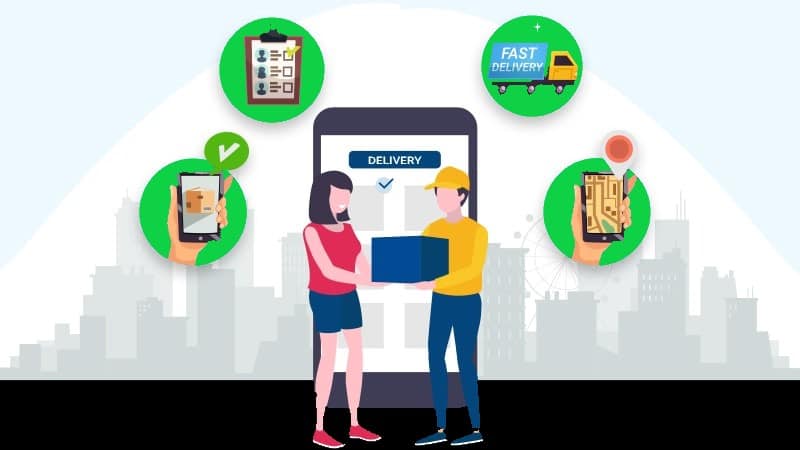The current pandemic has changed the functioning of the whole world. A lot of things have changed, including the fact that the masks have become a part of our accessories. Along with these changes in personal life, certain changes happened in the business. With the increase in the delivery orders and a decrease in manpower, robust final mile carrier tracking tools became critical to ensure high-levels of delivery productivity and sustainability. Along with this, there were also certain unexpected changes that drove the need for autonomous delivery systems.
This passage gives a detailed explanation of how the pandemic condition has changed the world of last-mile delivery for good. Let us now view these changes and understand how the pandemic situation has paved the way for a revolutionary future.
What is the last-mile delivery?
Last-mile delivery is the final step of the supply chain management that ensures the movement of goods and packages from the hub warehouse to be delivered to the people through delivery agents. With the improvement in the field of B2C deliveries, most e-commerce companies search for a perfect last-mile delivery tracking system. While some choose to adopt and build their in-house delivery system, other brands outsource their delivery options. Some of the basic challenges in last-mile delivery include transportation, transparency, hiring their warehouse, speed, and increasing efficiency.
Exponential growth in delivery
The pandemic has reduced the options of direct purchasing with new norms like social distancing. People have now opted for online purchases on all their requirements, including groceries and clothes. So currently, most of the brands depend upon the last-mile service providers for their delivery. The sector has experienced exponential growth in the areas of order placements and delivery. The increase in the hyperlocal delivery system has also increased the demand for drivers and delivery employees. So, the third-party logistics providers have managed to expand their services towards hyperlocal deliveries, cost-effective packaging, quicker deliveries, and warehousing.
The aggregators have understood the prerequisites for doorstep deliveries on a wide range of pin codes, and they have expanded their delivery system to meet the needs of the Pan India requirements.
The hyperlocal delivery system has forced last-mile delivery service providers to improve their speed through the automatic delivery system. Here the computer automatically processes the delivery addresses and assigns suitable drivers accordingly using the software installed in them. The availability of such software has allowed the last-mile delivery services to match up with their growing exponential rate.
Increasing demand for delivery executives
With the increase in online purchasing, the requirement for drivers has also increased. Online retailers and delivery companies are currently delivering products to more than 20,000 pin codes across the country. The increase in home delivery requirements has increased the demand for drivers.
To meet the requirements, Last-mile delivery services have opted for a self-delivery system that has improved their network to a certain extent. Along with this, they have also been considering using other forms of technological advancements to improve their speed and maintain transparency among the customers through online – streamlining of the entire process.
The combination of an auto-delivery system and online transparency has allowed the clients to get information about the location of the package and the person allocated to do it. So under emergency conditions, the clients can contact the drivers easily for quick delivery or if they have any personal requests.
Contactless deliveries for safety
With the current pandemic scenario existing in the world, most people have opted for a safety and hygiene based delivery system. This has forced the delivery boys to undertake safety precautions. To improve the conditions of the Last-mile deliveries, some of the modern techniques like drone-based deliveries, AI, and Big data have been used to create and improve their new idea on contactless delivery. Most of the groceries and food items are delivered using these techniques.
Even though the modern and advanced delivery system of Artificial Intelligence and drones have been implemented in certain areas, it is not possible for worldwide implementation. This is because of their prices, which will cause a huge hole in the funds. So most of them have opted for simple solutions of the mask and maintaining sterility in every step of the delivery. The advanced techniques are just a start that will be developed in the upcoming future but will take time because of the budget involved in it.
Challenges with providing free delivery
One of the major issues in such an advanced technology-based delivery system is the concept of free delivery. While certain brands like Amazon and other local brands are offering free deliveries, the expectations have increased from the side of the people. But in the current pandemic situation, the charges incurred during delivery have increased with the requirement for constant testing of the employees and other safety products like masks, gloves, and cleaning solutions.
These extra charges have made it more difficult for companies to offer free delivery. To keep up with such issues, the companies have switched most of their manual services towards automatic services to reduce the charges. Along with these, building an in-house delivery system will improve the speed and charges incurred during delivery. All these techniques combined will offer a perfect way to offer a free delivery system. Their main aim is to continue to offer free delivery options continuously to the people with profits.
These developments have changed the world of Last-mile deliveries, and people are expecting continuous online streaming of their package status to ensure safe delivery. These developments have also been implemented in the e-commerce logistics system to improve their delivery among tier-2 and tier 3 cities. Along with these advanced options, Logistics companies also use analysis tools to determine their performance and improve it in the upcoming future.




